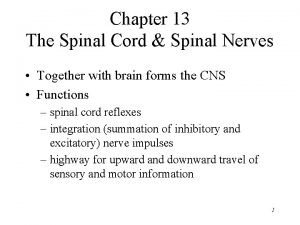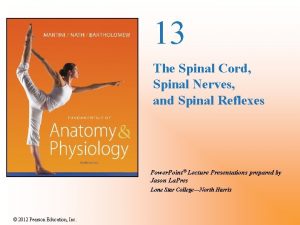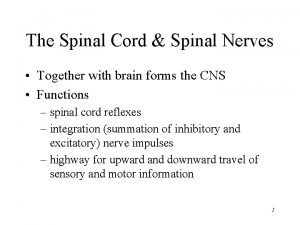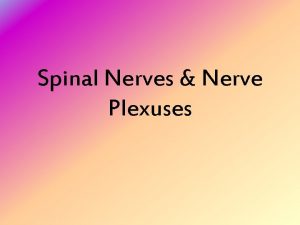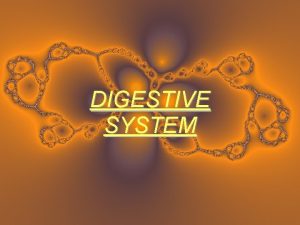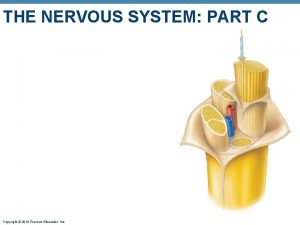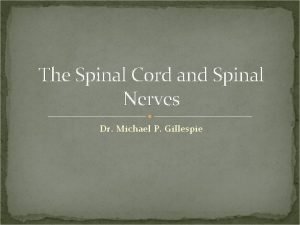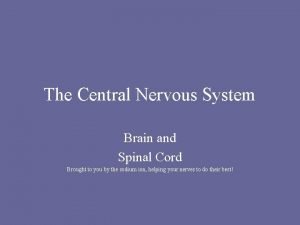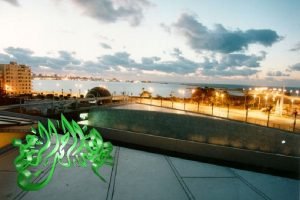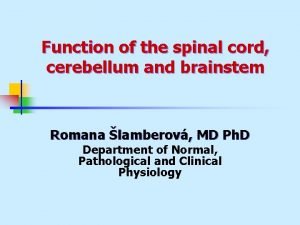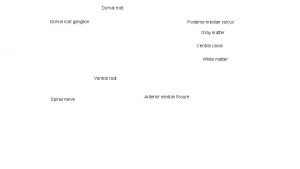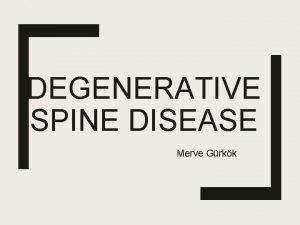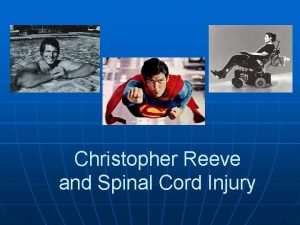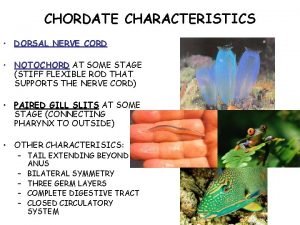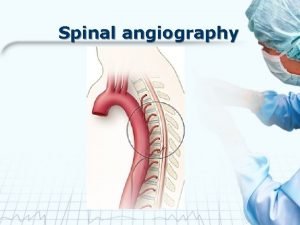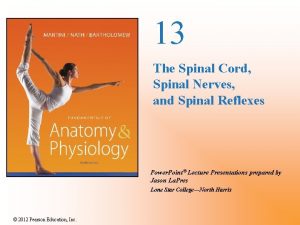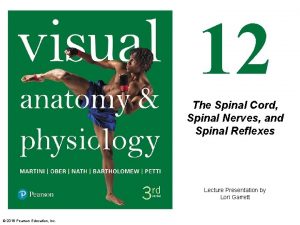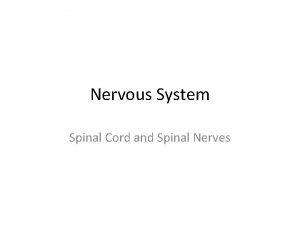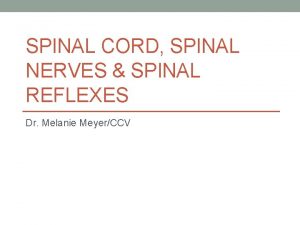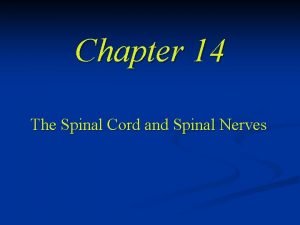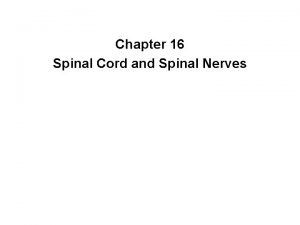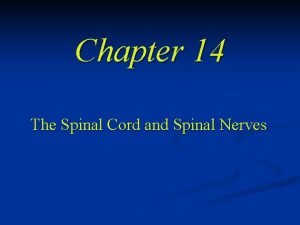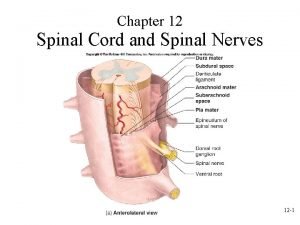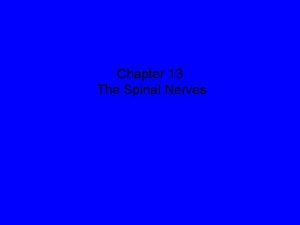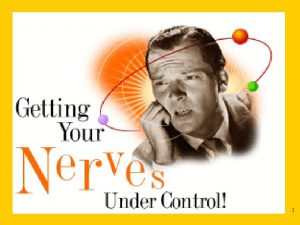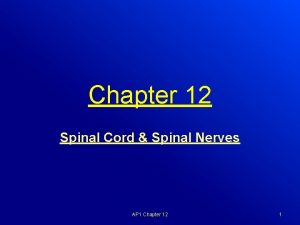Chapter 13 The Spinal Cord Spinal Nerves Spinal






























- Slides: 30

Chapter 13: The Spinal Cord, Spinal Nerves, & Spinal Reflexes © 2015 Pearson Education, Inc.

Homeostasis • Provides quick, reflexive responses to many stimuli • Pathway for sensory input to brain & motor output from brain © 2015 Pearson Education, Inc.

Figure 13 -1 An Overview of Chapters 13 and 14. CHAPTER 14: The Brain Sensory receptors Sensory input over cranial nerves Reflex centers in brain Motor output over cranial nerves Effectors Muscles CHAPTER 13: The Spinal Cord Glands Sensory receptors © 2015 Pearson Education, Inc. Sensory input over spinal nerves Reflex centers in spinal cord Motor output over spinal nerves Adipose tissue

Protective Structures Meninges White matter Ventral rootlets of spinal nerve Ventral root Gray matter Dorsal root ganglion Spinal nerve Dorsal rootlets of spinal nerve Meninges Pia mater ANTERIOR Subarachnoid space Vertebral body Rami communicantes Arachnoid mater Adipose tissue in epidural space Dorsal ramus Denticulate Dorsal root ligament ganglion POSTERIOR b A sectional view through the spinal cord and © 2015 Pearson Education, Inc. Autonomic (sympathetic) ganglion Ventral ramus Spinal cord spinal cord, showing the meningeal layers, superficial landmarks, and distribution of gray matter and white matter Pia mater Ventral root of spinal nerve Dura mater a A posterior view of the Dura mater Arachnoid mater meninges, showing the relationship of the meninges, spinal cord, and spinal nerves

Figure 13 -4 The Spinal Cord and Associated Structures. Spinal cord Anterior median fissure Pia mater Denticulate ligaments Dorsal root Ventral root, formed by several “rootlets” from one cervical segment Arachnoid mater (reflected) Dura mater (reflected) Spinal blood vessel © 2015 Pearson Education, Inc.

Figure 13 -2 Gross Anatomy of the Adult Spinal Cord. Posterior median sulcus Dorsal root ganglion Cervical spinal nerves C 1 C 2 C 3 C 4 C 5 C 6 C 7 C 8 White matter Central canal Cervical enlargement Gray matter Spinal Ventral nerve root Anterior median fissure C 3 T 1 T 2 T 3 T 4 T 5 T 6 T 7 KEY Spinal cord regions Thoracic spinal nerves T 8 T 9 = Cervical T 10 = Thoracic T 11 = Lumbar = Sacral T 12 L 1 Posterior median sulcus T 3 Lumbar enlargement Conus medullaris L 2 Lumbar spinal nerves L 3 Inferior tip of spinal cord L 4 Cauda equina L 5 L 1 Sacral spinal nerves S 1 S 2 S 3 S 4 S 5 Coccygeal nerve (Co 1) Filum terminale (in coccygeal ligament) S 2 b Inferior views of cross sections through representative segments of the spinal cord, showing the arrangement of gray matter and white matter. a The superficial anatomy and orientation of the adult spinal cord. The numbers to the left identify the spinal nerves and indicate where the nerve roots leave the vertebral canal. The adult spinal cord extends from the brain only to the level of vertebrae L 1–L 2; the spinal segments found at representative locations are indicated in the cross sections. © 2015 Pearson Education, Inc.

Figure 13 -2 b Gross Anatomy of the Adult Spinal Cord. Posterior median sulcus Dorsal root ganglion White matter Gray matter Central canal Spinal Ventral root nerve Anterior median fissure C 3 L 1 b Inferior views of cross sections through representative segments of the spinal cord, showing the arrangement of gray matter and white matter. © 2015 Pearson Education, Inc. T 3 S 2

Figure 13 -5 The Sectional Organization of the Spinal Cord. Posterior white column Posterior median sulcus Functional Organization of Gray Matter Posterior gray commissure Posterior gray horn Dorsal root ganglion Lateral white column The cell bodies of neurons in the gray matter of the spinal cord are organized into functional groups called nuclei. Somatic Sensory nuclei Lateral gray horn Visceral Anterior gray horn Motor nuclei Somatic Ventral root Anterior gray commissure Anterior white column Anterior white commissure Anterior median fissure a The left half of this sectional view shows important anatomical landmarks, including the three columns of white matter. The right half indicates the functional organization of the nuclei in the anterior, lateral, and posterior gray horns. POSTERIOR Structural Organization of Gray Matter Posterior median sulcus The projections of gray matter toward the outer surface of the spinal cord are called horns. Posterior gray commissure Posterior gray horn Dura mater Lateral gray horn Arachnoid mater (broken) Dorsal root Central canal Anterior gray horn Anterior gray commissure Anterior median fissure Pia mater ANTERIOR Dorsal root ganglion Ventral root b A micrograph of a transverse section through the spinal cord, showing major landmarks in and surrounding the cord. © 2015 Pearson Education, Inc.

Figure 13 -8 Peripheral Distribution of Spinal Nerves. © 2015 Pearson Education, Inc.

Spinal Nerves • 31 pairs – – – 8 prs cervical 12 prs thoracic 5 prs lumbar 5 prs sacral 1 pr coccygeal • Formed by union of posterior & anterior roots so they are mixed nerves • Consist of many axons & covered by layers of protective CT © 2015 Pearson Education, Inc.

Figure 13 -6 A Peripheral Nerve. Blood vessels Connective Tissue Layers Epineurium covering peripheral nerve Perineurium (around one fascicle) Endoneurium Schwann cell Myelinated axon Fascicle a A typical peripheral nerve and its connective tissue wrappings © 2015 Pearson Education, Inc. b A scanning electron micrograph showing the various layers in great detail (SEM × 340)

Figure 13 -8 Peripheral Distribution of Spinal Nerves (Part 1 of 2). From interoceptors of back 4 From exteroceptors, proprioceptors of back The dorsal root of each spinal nerve carriers sensory information to the spinal cord. 3 The dorsal ramus carries sensory information from the skin and skeletal muscles of the back. Somatic sensory nuclei 2 The ventral ramus carries sensory information from the ventrolateral body surface, structures in the body, wall, and the limbs. Dorsal root ganglion From exteroceptors, proprioceptors of body wall, limbs From interoceptors of body wall, limbs Rami communicantes Ventral root KEY = Somatic sensations = Visceral sensations © 2015 Pearson Education, Inc. Visceral sensory nuclei 1 The sympathetic nerve carriers sensory information from the visceral organs. From interceptors of visceral organs

Figure 13 -8 Peripheral Distribution of Spinal Nerves (Part 2 of 2). To skeletal muscles of back Postganglionic fibers to smooth muscles, glands, etc. , of back 2 The spinal nerve forms just lateral to the intervertebral foramen, where the dorsal and ventral roots unite. 3 Dorsal root ganglion The dorsal ramus contains somatic motor and visceral motor fibers that innervate the skin and skeletal muscles of the back. 4 The axons in the relatively large ventral ramus supply the ventrolateral body surface, structures in the body wall, and the limbs. 1 The ventral root of each spinal nerve contains the axons of somatic motor and visceral motor neurons. Visceral motor nuclei To skeletal muscles of body wall, limbs Somatic motor nuclei Rami communicantes KEY = Somatic motor commands = Visceral motor commands Postganglionic fibers to smooth muscles, glands, visceral organs in thoracic cavity Preganglionic fibers to sympathetic ganglia innervating abdominopelvic viscera © 2015 Pearson Education, Inc. Sympathetic ganglion 7 Postganglionic fibers to smooth muscles, and glands of body wall, limbs 5 The white ramus communicans is the first branch from the spinal nerve and carries visceral motor fibers to a nearby sympathetic ganglion. Because these preganglionic axons are myelinated, this branch has a light color and is therefore known as the white ramus. White rami are only found between T 1 and L 2. A sympathetic nerve contains preganglionic and postganglionic fibers innervating structures in the thoracic cavity. 1 6 The gray ramus communicans contains preganglionic fibers that innervate glands and smooth muscles in the body wall or limbs. These fibers are unmyelinated and have a dark gray color. Gray rami are associated with each spinal nerve.

Plexuses • Axons of anterior rami form networks by joining with other axons of anterior rami © 2015 Pearson Education, Inc.

Figure 13 -10 The Cervical Plexus. Nerves of the Cervical Plexus Spinal Segments Nerve and Distribution Great Auricular Cranial Nerves C 2–C 3 Accessory nerve (N XII) Skin over the posterior aspect of the ear and the neck Lesser Occipital Hypoglossal nerve (N XII) C 2 Skin of the neck and the scalp posterior and superior to the ear Transverse Cervical Nerve Roots of Cervical Plexus C 3–C 4 C 1 Skin of the anterior triangle of the neck Ansa Cervicalis C 2 C 3 C 1–C 4 C 5 Five of the extrinsic laryngeal muscles by way of cranial nerve XII Geniohyoid muscle Thyrohyoid muscle Omohyoid muscle Sternothyroid muscle Sternohyoid muscle Clavicle Phrenic C 3–C 5 Diaphragm Supraclaviculars C 3–C 4 © 2015 Pearson Education, Inc. Skin of the neck and shoulder

Figure 13 -11 The Brachial Plexus. © 2015 Pearson Education, Inc.

Figure 13 -12 The Lumbar and Sacral Plexuses. Nerve Roots of Lumbar Plexus Spinal Segments Iliohypogastric nerve Ilioinguinal nerve Genitofemoral nerve Nerve and Distribution Lateral femoral cutaneous nerve Iliohypogastric Femoral nerve External and internal oblique and transverse abdominis muscles; skin over the inferior abdomen and buttocks Obturator nerve Superior gluteal nerve Ilioinguinal Superior gluteal nerve Inferior gluteal nerve Pudendal nerve Posterior femoral cutaneous nerve Sciatic nerve Inferior gluteal nerve Abdominal muscles (with iliohypogastric nerve); skin over superior, medial thigh and portions of external genitalia Pudendal nerve Genitofemoral Posterior femoral cutaneous nerve (cut) Sciatic nerve Skin over anteromedial thigh and portions of external genitalia Lateral Femoral Cutaneous Skin over anterior, lateral, and posterior thigh Saphenous nerve Femoral Tibial nerve Common fibular nerve Quadriceps, sartorius, pectineus, and iliopsoas muscles; skin of the anteromedial thigh, and medial surface of the leg and foot Lumbosacral trunk Obturator Gracilis, and adductor magnus, brevis and longus muscles; skin from the medial surface of the thigh a Lumbar plexus, anterior view Superficial fibular nerve Nerve Roots of Sacral Plexus Lumbosacral trunk Sacral Plexus Spinal Segments Nerve and Distribution and sacral plexuses, anterior view Gluteus minimus, gluteus medius, and tensor fasciae latae muscles Inferior Gluteal Gluteus maximus muscle Sacrum Skin over perineum and posterior thigh and leg Sciatic Semimembranosus, semitendinosus, and adductor magnus muscles; branches into tibial and fibular nerves Pudendal Muscles of the perineum; skin over external genitalia, bulbospongiosus and ischiocavernosus muscles b Sacral plexus, anterior view © 2015 Pearson Education, Inc. Sural nerve Deep fibular nerve c Nerves of the lumbar Superior Gluteal Posterior Femoral Cutaneous Common fibular nerve d Nerves of the sacral plexus, posterior view

Intercostal Nerves • Anterior rami of T 2 -T 12 © 2015 Pearson Education, Inc.

Dermatomes • Area of skin that provides sensory input to CNS via 1 pair of spinal nerves • Allows us to locate damage NV C 2–C 3 C 2 C 3 T 2 C 6 L 1 L 2 C 8 T 1 C 7 L 3 L 4 KEY Spinal cord regions L 5 C 3 C 4 C 5 T 1 T 2 T 3 T 4 T 5 T 6 T 7 T 8 T 9 T 10 T 11 T 12 S 2 T 3 T 4 T 5 T 6 T 7 T 8 T 9 T 10 T 11 T 12 L 1 L 2 L 4 L 3 L 5 C 4 C 5 T 2 C 6 T 1 C 7 S 4 S 3 L 1 S 5 C 8 S 1 L 5 L 2 S 2 L 3 = Cervical = Thoracic = Lumbar S 1 = Sacral L 4 ANTERIOR © 2015 Pearson Education, Inc. POSTERIOR

Clinical Note 13 -2 Sensory Innervation in the Hand. Radial nerve Ulnar nerve Median nerve Anterior © 2015 Pearson Education, Inc. Posterior

Clinical Note 13 -3 Sensory Innervation in the Ankle and Foot. Saphenous nerve Sural nerve Fibular nerve Tibial nerve Sural nerve Saphenous nerve Tibial nerve © 2015 Pearson Education, Inc. Saphenous nerve Sural nerve Fibular nerve

Sensory Tracts Dorsal root ganglion Dorsal root Posterior column pathway Fasciculus gracilis Fasciculus cuneatus Spinocerebellar pathway Posterior spinocerebellar tract Anterior spinocerebellar tract Spinothalamic pathway Ventral root © 2015 Pearson Education, Inc. Lateral spinothalamic tract Anterior spinothalamic tract

Motor Tracts Corticospinal pathway Lateral corticospinal tract Anterior corticospinal tract Lateral pathway Rubrospinal tract Medial pathway Reticulospinal tract Tectospinal tract Vestibulospinal tract © 2015 Pearson Education, Inc.

Reflexes • Fast, involuntary, unplanned sequence of actions that occurs in response to a particular stimulus © 2015 Pearson Education, Inc.

Figure 13 -15 The Classification of Reflexes can be classified by development Innate Reflexes • Genetically determined Acquired Reflexes • Learned response complexity of circuit processing site Somatic Reflexes Monosynaptic Spinal Reflexes • Control skeletal muscle contractions • Include superficial and stretch reflexes Visceral (Autonomic) Reflexes • Control actions of smooth and cardiac muscles, glands, and adipose tissue © 2015 Pearson Education, Inc. • One synapse Polysynaptic • Multiple synapses (two to several hundred) • Processing in the spinal cord Cranial Reflexes • Processing in the brain

Reflex Arc • Components – – – Sensory receptor Sensory neuron Integrating center Motor neuron Effector 1 Arrival of stimulus and activation of receptor 2 Dorsal root Activation of a sensory neuron Sensation relayed to the brain by axon collaterals Spinal cord Stimulus Receptor 3 Information processing in the CNS REFLEX ARC 5 Response by a peripheral effector Effector 4 Ventral root Activation of a motor neuron © 2015 Pearson Education, Inc. KEY Sensory neuron (stimulated) Excitatory interneuron Motor neuron (stimulated)

Stretch Reflex • • Skeletal muscle contracts in response to stretching to prevent overstretching Monosynaptic & ipsilateral Stretch Receptor (muscle spindle) Spinal cord REFLEX ARC Stimulus Contraction Effector KEY Response © 2015 Pearson Education, Inc. Sensory neuron (stimulated) Motor neuron (stimulated)

Flexor Reflex • Aka withdrawal reflex • Polysynaptic & ipsilateral • Pulls body part away from source of possibly damaging stimulus Distribution within gray horns to other segments of the spinal cord Painful stimulus Flexors stimulated Extensors inhibited © 2015 Pearson Education, Inc.

Crossed Extensor Reflex To motor neurons in other segments of the spinal cord • Polysynaptic & contralateral • Helps you maintain your balance • Usually paired with flexor reflex Extensors inhibited Flexors stimulated Extensors stimulated Flexors inhibited KEY Sensory neuron (stimulated) Motor neuron (inhibited) Excitatory interneuron Inhibitory interneuron Motor neuron (stimulated) © 2015 Pearson Education, Inc. Painful stimulus

The Babinski Reflex a The plantar reflex (negative Babinski reflex), a curling of the toes, is seen in healthy adults. © 2015 Pearson Education, Inc. b The Babinski sign (positive Babinski reflex) occurs in the absence of descending inhibition. It is normal in infants, but pathological in adults.
 Spinal cord
Spinal cord Innervations of the brachial and lumbar enlargements
Innervations of the brachial and lumbar enlargements Cervical and brachial plexus
Cervical and brachial plexus Nerves branching beyond the spinal cord into the body
Nerves branching beyond the spinal cord into the body Spinal cord and spinal meninges
Spinal cord and spinal meninges Visceral nervous system
Visceral nervous system Spinal cord cover
Spinal cord cover Cervical nerve exit
Cervical nerve exit Neural circuits the organization of neuronal pools
Neural circuits the organization of neuronal pools Spinal nerves
Spinal nerves The spinal nerves
The spinal nerves Spinal cord grooves
Spinal cord grooves Frog spinal nerves
Frog spinal nerves Structure of spinal cord
Structure of spinal cord Central nervous system
Central nervous system Cervical nerves
Cervical nerves Spinal cord denticulate ligament
Spinal cord denticulate ligament Spinal cord structures
Spinal cord structures Causes of spinal cord compression
Causes of spinal cord compression Spinal cord
Spinal cord Extrapyramidal tract function
Extrapyramidal tract function Ventral median fissure
Ventral median fissure Spinal cord extends from
Spinal cord extends from Christopher reeve spinal cord injury level
Christopher reeve spinal cord injury level Dorsal nerve cord vs notochord
Dorsal nerve cord vs notochord Slidetodoc.com
Slidetodoc.com Spinal cord organization
Spinal cord organization Crossed extensor reflex
Crossed extensor reflex Tethered spinal cord
Tethered spinal cord Spinal angiogram
Spinal angiogram Stretch reflex
Stretch reflex






